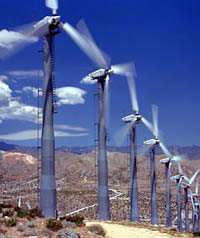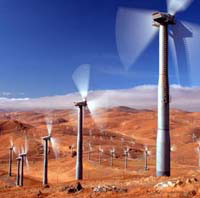The National Audubon Society hosted a news conference in September 1999 to denounce Enron Wind Corp.’s plans to build a wind farm near the town of Gorman in Southern California, with enough capacity to power 40,000 homes. “It is hard to imagine a worse idea than putting a condor Cuisinart next door to critical condor habitat,” said Audubon Vice Pres. Daniel Beard.

Condor Cuisinarts?
Photo: Warren Gretz, NREL/PIX.
Many environmentalists are touting wind energy as the wave of the future, the technology most likely to help us steer away from the path to climate disaster. Wind power is the fastest growing energy source in the world, and the U.S. just set an all-time one-year record for installations between June of 1998 and 1999. But wind farms also stir up heated controversies within the environmental community, often centered around the issue of potential bird fatalities.
After an expensive and high-profile federal reintroduction effort, the California condor population in the wild now totals 49 birds, with 20 living in Southern California in the region where Enron was considering constructing a 44-megawatt (MW) wind facility. “We believe this project must be stopped,” Beard told the press. “Enron is proposing to build a death trap.”
A couple months later, after a successful campaign to change Enron’s plans, Beard sounded like a completely different person. “Wind power is a clean, nonpolluting source of electricity, producing no acid rain, oil spills, or radioactive waste,” he said in early November when he announced that Enron had abandoned its plans for the controversial wind farm and was instead looking into developing a facility in a more remote area not frequented by condors. “Enron Wind has a long history of dealing with environmental concerns in a positive, responsible manner,” Beard said. “Enron Wind has again clearly proven that it is a company committed to protecting the environment and the region’s wildlife.”
Audubon’s change of heart toward Enron is easy enough to understand — wind turbines are great so long as they aren’t situated where they might dice up protected, popular bird species. Audubon’s approach to battling Enron — namely, teaming up with Tejon Ranch Co., a ranching outfit and major real estate developer — is a little harder to make sense of.
Save the Condors — or the Condos?
Tejon — whose backers include the Chandler family, which owns the Los Angeles Times — has title to the largest private real estate parcel in California, 270,000 acres of contiguous land between Los Angeles and Bakersfield. Tejon’s cattle operations provide about 60 percent of its revenues, and the company touts its properties to film studios as ideal backdrops for movies set everywhere from deserts to forests. But the future of the company lies in real estate development, and Tejon has long worried about what wind turbines might do to its plans to build posh homes and condos.

Cuddly condor.
Photo: Neil Johnson, Los Angeles
Zoo, courtesy of Calif.
Dept. of Fish and Game.
Tejon linked up with the Audubon Society and helped bankroll its campaign against Enron. The company paid for newspaper ads in Washington, D.C., denouncing the proposed Gorman area wind farm, and for billboards in Los Angeles and Enron’s home city of Houston featuring a raptor heading into wind turbines, with the caption “Kill the Condors?”
This wasn’t the first time Tejon had teamed up with environmentalists against wind power, allegedly out of concern for birds. In 1989, Tejon joined forces with the Sierra Club and Audubon to kill a 77-MW wind farm proposed for the very same area near Gorman.
But Tejon’s concern for condors seems to be highly selective. In 1997, the company filed suit to halt condor reintroduction in the Tehachapi Mountains in southern California, fearing it could hamper its plans for development.
The company’s concern for condos, however, is unwavering — and may point to its real reason for fighting against turbines. In an interview, Tejon general counsel Dennis Mullins made it clear he is no big fan of wind energy. He described the potential wind farm near Gorman as “a visual blight 12 o’clock high at the gateway to Kern Country.” But sprawling development is apparently no visual blight in the eyes of Tejon. The company recently struck a deal with three top U.S. home builders to develop 4,000 acres adjacent to the land near Gorman that Enron had been eyeing, and plans for a huge mall are also in the works.
If You Build It, Birds Won’t Come
Wind turbines do result in some bird fatalities — even the biggest wind power boosters don’t deny it. But for wildlife advocates to single out wind power for criticism in the face of so many other threats to birds seems shortsighted, particularly when they team up with developers in the face of mounting concern about the effects of sprawl on bird habitat.

Wind turbines in the Altamont Pass.
Photo: Warren Gretz, NREL/PIX.
Take the case of the Altamont Pass, an area southeast of San Francisco with more than 5,000 wind turbines that are frequent targets of criticism from conservationists concerned about bird populations.
From 1994 to 1998, Grainger Hunt, an ecologist with the Predatory Bird Research Group of the University of California at Santa Cruz, conducted the most comprehensive study to date on eagle populations in the Altamont Pass. In a report to the National Renewable Energy Laboratory, Hunt declared that the overall population of golden eagles was in slight decline due to the wind farms.
But according to Paul Kerlinger, a scientist and author specializing in bird behavior, it’s unclear whether the small decline Hunt observed is due to the wind farms or to human land-use patterns and development in the region. Kerlinger points out that since the mid-’90s, when Hunt’s bird monitoring program began, “a new reservoir destroyed foraging and nesting habitat within the wind resource area; the City of Livermore has pushed its boundaries up against the wind farms; and it is beginning to look like the oak trees that exist outside the wind resource area are not coming back due to cattle grazing. These are the oaks golden eagles nest in. As the trees go, so go the eagles.”

A golden eagle watches his
territory shrink.
Photo: Dr. Lloyd Glenn Ingles,
California Academy of Sciences.
Ken Sanchez, a U.S. Fish and Wildlife Service senior biologist based in Sacramento, also said that eagle populations have been “hammered” by development sprawling out from San Francisco into the “highest density golden eagle nesting site” known. “I agree that wind farms are better than subdivisions,” he said.
There are also real dangers to not pursuing the full promise of wind power. “No one seems to pay much attention to the number of birds that are fried by transmission and distribution lines that transport power from nuclear and coal plants,” said V. John White, executive director of the Sacramento-based Center for Energy Efficiency and Renewable Technologies. “When one steps back and takes a good look at the big picture, the level of bird kills coming from wind turbines is completely dwarfed by the looming catastrophe of global warming and air pollution impacts associated with the present status quo energy picture.”
Fortu
nately, the Audubon Society and other environmental groups that have fought against wind farms in past years seem to be gradually reconciling themselves to the fact that wind power is here to stay and seems to be our best bet for beating back climate change.
In 1998, 2,100 MW of new wind energy generating capacity were added around the globe, 35 percent more capacity than was added in 1997. In June 1999, U.S. Energy Secretary Bill Richardson launched a strategic initiative with the aim of providing at least 5 percent of U.S. electricity from wind energy by the year 2020. That would equate to 80,000 MW of new wind power capacity over the next two decades, an average of 4,000 MW per year — a marked increase over the pace of recent record-setting development. And all signs point to continuing dramatic growth.


